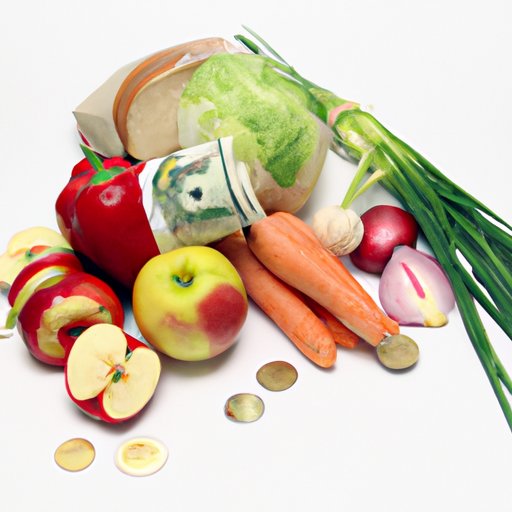Introduction
Eating healthy is a priority for many people, yet the prices of health foods can often be prohibitive. Why is healthy food so expensive? This article will explore this question by examining the factors that affect the cost of production, the role of retailers in setting prices, and the impact of supply and demand on prices. Ultimately, solutions will be provided to help make healthy food more affordable.
Analyzing the Cost of Production for Healthy Foods
Producing healthy food requires additional resources and labor compared to conventional farming methods, which include the use of synthetic fertilizers and pesticides. As a result, the cost of production for healthy food is generally higher.
Factors Affecting Cost of Production
Organic farming, for example, requires more labor because it eliminates the use of synthetic fertilizers and pesticides. According to a study conducted by the Organic Trade Association, “Organic food production requires more labor than conventional production methods, resulting in higher costs for organic farmers.” The study found that organic farmers pay an average of 20 percent more in labor costs than conventional farmers.
In addition, organic farming requires more land than conventional farming. This is because organic farming uses crop rotations and cover crops, which take up additional space. As a result, organic farms tend to be smaller and produce less overall, leading to higher costs of production.
Impact of Government Subsidies
Government subsidies also play a role in the cost of production for healthy food. Conventional farmers receive generous subsidies from the government, which helps to reduce the cost of production. In contrast, organic farmers receive very little in subsidies, resulting in higher costs for organic food.
Effects of Food Inflation
Food inflation is another factor that affects the cost of production for healthy food. According to the Bureau of Labor Statistics, food prices have increased by an average of 3.5% annually since 2010. This means that the cost of production for healthy food has gone up as well, leading to higher prices for consumers.

Examining the Role of Retailers in Setting Prices
Retailers also play a role in setting prices for healthy food. Retailers use various pricing strategies to maximize profits, such as setting high prices for certain items and offering discounts on others. These strategies can contribute to the higher cost of healthy food.
Pricing Strategies Used by Retailers
Retailers often use a combination of high-low pricing, promotional pricing, and bundling to set prices for healthy food. High-low pricing involves setting high prices for some items and lower prices for others. Promotional pricing involves offering discounts, coupons, and other incentives to encourage customers to buy. Finally, bundling involves selling multiple items together at a discounted rate.
Impact of Consumer Demand on Prices
Consumer demand also affects the prices of healthy food. When demand is high, prices tend to increase as retailers try to capitalize on the popularity of certain products. In contrast, when demand is low, prices may decrease as retailers try to attract customers.

Assessing the Effect of Supply and Demand on Prices
Finally, the law of supply and demand plays an important role in determining the prices of healthy food. When the supply of a product is low and the demand is high, prices tend to increase. Conversely, when the supply is high and the demand is low, prices tend to decrease.
Overview of Supply and Demand
The law of supply and demand states that when the supply of a product is low and the demand is high, prices tend to increase. This is because there is more competition for the product, and sellers can charge a higher price. Conversely, when the supply is high and the demand is low, prices tend to decrease. This is because there is less competition for the product, and sellers have to lower their prices to attract buyers.
Relationship between Supply and Demand and Prices
The relationship between supply and demand and prices is complex. When the demand for healthy food increases, the supply may not be able to keep up, resulting in higher prices. Similarly, when the supply of healthy food increases, the demand may not be able to keep up, resulting in lower prices. In either case, the cost of production and the strategies used by retailers also play a role in determining prices.
Conclusion
This article has explored why healthy food is so expensive by analyzing the factors that affect its cost of production, the role of retailers in setting prices, and the impact of supply and demand on prices. It is clear that there are many factors that contribute to the higher cost of healthy food, but there are also solutions that can help make healthy food more affordable.
Summary of Findings
The cost of production for healthy food is generally higher due to the use of organic farming methods, the lack of government subsidies, and food inflation. Retailers also play a role in setting prices using high-low pricing, promotional pricing, and bundling. Finally, the law of supply and demand affects prices, as does the cost of production and the strategies used by retailers.
Recommendations for Consumers
Consumers can take steps to make healthy food more affordable. Shopping at farmers markets and joining a CSA (community supported agriculture) are two ways to access fresh, local, and often organic produce at lower prices. Buying in bulk, taking advantage of promotions and coupons, and growing your own food are also effective ways to save money on healthy food.
(Note: Is this article not meeting your expectations? Do you have knowledge or insights to share? Unlock new opportunities and expand your reach by joining our authors team. Click Registration to join us and share your expertise with our readers.)
